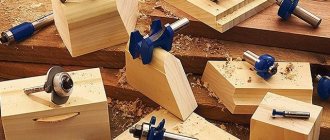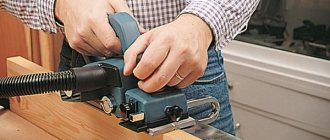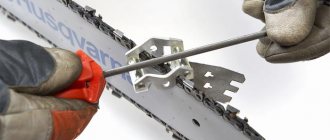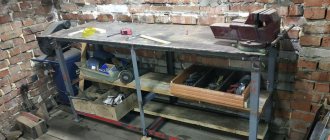All manufacturers of door structures usually offer their products without locks. Door models can sometimes have a locking device installed, which is more reminiscent of a regular latch and does not perform protective functions against burglary. Therefore, the buyer will have to insert the lock into the wooden interior door independently, with or without the help of a router.
Nuances of choice
When choosing tools and cutters, you should pay attention to several points.
First of all, you need to consider the frequency of use of the router. If the amount of work is small, you can choose inexpensive models. If you purchase a tool for frequent or professional use, it is best to take a closer look at more expensive and branded models. Often, cutters are sold in sets that are designed for specific types of work.
Regarding the selection of cutters, the following factors must be taken into account:
- the material from which the equipment is made;
- soldering quality;
- thermal strength;
- type of connection between the shank and the cutting part;
- size compatibility between tool and cutter;
- shank size;
- blade position.
When choosing equipment for a tool, you should inspect the cutters to check the quality of soldering and eliminate defects. The soldering of the equipment must be made so that the router does not lose its longitudinal stability during long-term processing
This is especially important if you have to work with hard wood.
Let's pay attention to the solder. The highest quality brands are PSr40 or PSr37.5, which contain increased levels of copper and silver
Additions in other brands usually contain nickel, which negatively affects the strength of the connection between the cutting part and the shank.
The characteristics of the base metal are divided into 2 types:
- designation HM - classified as high-speed, used in working with soft wood, but can be used in processing aluminum;
- designation HSS - made of hard metal alloy, used in working with hard wood, bronze, metal and plastic.
If possible, it is better to choose products with the HSS designation. They are more expensive than high-speed cutters, but the characteristics of such cutters are much better. The connection between the cutting part and the shank should under no circumstances be made by welding.
A fairly simple and important detail that you can forget about when checking is the dimensions. The equipment must be suitable in size for the tool. In the set, the router is equipped with collets or bushings with which the cutter is secured - the size of the selected equipment depends on their parameters. The size is indicated in millimeters or inches. The blades can be positioned at an angle or parallel.
This leads to physical difficulties during the work process, and the surface will need to be sanded. It follows from this that it is best to use equipment with vertical blades for preliminary work, and use inclined blades at the final stages of work. A good, high-quality cutter will not cause problems in operation and will not become dull during the first uses. As for choosing a manufacturer's brand, it is best not to purchase cutters from unknown manufacturers. Beginners and amateurs should consult with the seller or read reviews of brands before making a purchase.
Design Features
Not the least role in the quality indicators of reliability is given to installation work; however, when creating a design, additional safety measures are used, which are achieved through the following indicators:
- The thickness of the steel sheets used to form the door leaf increases, reaching 3 mm.
For standard products, the thickness of the steel sheet relative to the requirements of GOST standards should even exceed 3 mm.
Internal doors are subject to more stringent, far from conditional requirements, which consist in the installation of additional reinforced stiffeners in the door leaf.
At the same time, standard entrance doors are equipped with only two or a maximum of three horizontally directed stiffeners, while internal doors are equipped with a combination of vertical and horizontal stiffeners. Thus, a unique, in visual perception, steel mesh made from a square section profile or from an angular profile makes it possible to eliminate deformations and mechanical damage to the door leaf.
The weak point of many internal opening doors is the vestibule; by the way, it is worth noting that interior units are on the same list. The design of the entrance type cannot afford such a disadvantage as a gap between the sash and the frame for many reasons.
If the interior blocks can be additionally and quite easily eliminated from the existing gap in the vestibule, then the entrance fabrications are quite difficult to reconstruct in this direction. At the same time, the existing gap in the vestibule opens up more opportunities for unauthorized entry into the building. They get rid of a typical problem during the manufacturing process of the structure in factory or factory conditions, by strengthening the site in the locking area. Thus, any type of impact, including a mechanical nature, is prevented in the bud.
How to disassemble the door handle of a round type interior door
The method of dismantling round door handles for interior doors may differ depending on the design features of the fittings. The most convenient are products that have two tightening screws. In this case, it is easiest to dismantle it yourself. To do this, you need to unscrew the fixing elements and remove the mechanism.
However, there are situations that require great effort. Mechanisms that are more complex from a constructive point of view are dismantled in several stages. On modern interior doors, round parts equipped with a button and various decorative elements are quite often found. The function of such covers is to hide the mounting screws. How to remove the handle from the interior door in this case?
To remove the round handle, you must first remove the outer part of the device
In order to dismantle the handle with the button and decorative overlays, it is first necessary to remove the outer part of the mechanism, which is attached using a special button. Next, you need to eliminate the linings that hide the retaining elements.
If the handle is damaged, it can be repaired. How to repair an interior door handle? First of all, you need to find out the nature of the damage. Based on this information, the necessary instructions are selected and the mechanism is rehabilitated. It is recommended that before dismantling the old handle, you determine its type and study the design features. To eliminate the round handle mechanism, experts advise reading the more detailed instructions.
https://youtube.com/watch?v=CPZAOlJomtg
Preparing to cut in canopies
Cutting canopies with a router
This procedure is the most common and is used both when replacing an old door and when installing a new one. In addition to the cutter, you will also need an ordinary carpenter's ruler, as can be seen in the video.
At the first stage, it is necessary to mark the frame for the existing hinges of the interior door so that the adjustment takes place quickly and correctly. The position of the hinges should be adjusted taking into account the least likely distortions when opening/closing the door. Marking can also be done using a special template that you can make yourself. Sometimes an unnecessary fragment of door molding, the dimensions of which coincide with the dimensions of the door frame, is also adapted to the template.
First, one of the edges should be trimmed. The marked square is installed on the outer sides of the door and strips of adhesive tape are glued in the necessary places - they will serve as a kind of limiter for the movement of the router.
Recess for the locking part
Before embedding the lock into the interior door, mark the selected height on the door. Make this more convenient using a tape measure. We place a mark at the end and transfer it using a square or building level to both sides of the door leaf.
- Take the lock/latch and apply it to the end of the door so that the middle of the lock falls on the drawn line. We mark the width of the metal locking part and the level at which the lining ends.
- We take a 16 mm feather drill and apply it to the part of the lock that will be inserted into the door leaf. Using a marker or masking tape, or a piece of electrical tape, make a mark on the drill. This mark should be slightly further than the lock. We will use it to guide us to what depth to make the holes. This is especially important if the lock is installed against glass. Otherwise, you may drill too deep and damage the glass.
We put a mark on the feather drill - this way we will control the drilling depth - Having installed a feather drill, we make several holes one under the other, forming a recess for the lock. The number of holes depends on the size of the lock. In some models 4-6 are enough, in others you will need 8-10.
- The edges of the holes were uneven, and the wood had lifted in places. We take a chisel and remove the protruding wood fibers from the edges, working lightly and in depth (but don’t get too carried away).
The edges turned out uneven, remove the protruding fibers using a chisel - We take a regular 16 mm drill and put it in the drill. Use it to align the edges of the hole made. To do this, move it up and down, pressing lightly on one side or the other of the notch. This operation is needed to speed up the process, but the drill must be strictly controlled. If you are unsure, it is better to level the notch using a chisel and mallet.
Leveling faster with a drill - Insert the lock into the resulting hole. It is usually a little larger, so there are no problems. If necessary, using a chisel or drill it can be increased to the desired size.
- We set the lock to the desired position and attach it to the door leaf using two self-tapping screws (one at the top, the other at the bottom).
How to embed a lock into an interior door: modifying the recess - Using a pencil or a utility knife, trace the perimeter of the lock lining. We remove the lock, take a chisel and remove 1-2 mm of wood, MDF or veneer inside the markings made.
Don't miss: Interior doors made of bleached oak: the best combination with other colors in the interior - photo
The depth of the recess for the locking part depends on the thickness of the decorative strip. Usually they try to make sure that the strip is flush with the end of the door, but it may protrude a little. Shoot little by little as you work—it’s easier to edit it than to try to restore what you shot.
We put the handles
To finish installing the lock on the interior door, you need to make holes for installing handles. The work is much less than what has already been done, but accuracy is required. Mistakes are not too critical, although it is better to try to avoid them.
The handles come complete with self-tapping screws for wooden doors and tie bolts for installation in a metal door. It is better to replace the self-tapping screws from the kit - they are usually made of soft metal. Unless you bought a branded foreign lock, in which the screws are hardened. And so, buy several good screws with a diameter of 1.5-2 mm and a length of about 1 cm.
- We take the lock and apply it to the side surface of the door, matching the height.
- Using a pencil, marker or awl, we make marks through the slots for installing handles.
We make marks on both sides of the door - We repeat the operation on the other side of the door leaf.
- We install a crown or a feather drill of a suitable diameter on the drill. Place the center of the drill/bit at the marks and make holes. An important point: we do not drill through, but from both sides, towards each other. That is, as soon as the drill falls into the recess made for the lock, we stop the work and start from the other side.
- We remove the shavings from the recess for the lock, put the lock plate in place, and secure it with self-tapping screws.
- We loosen the clamping screws on the handles - the central rod should “move” freely, and install it in place.
We install and secure the handles - Align and fasten with self-tapping screws. It is better to pre-drill holes in veneered doors.
- You just need to tighten the fastening screw that connects the two handles and the lock cylinder. They are usually located on the underside of the handle. Take a screwdriver and tighten the screws on both handles.
Installing decorative trims
Some models have decorative overlays. We align them using a square.
Installing the lock latch
Locks for interior doors usually have a rotating latch on one side that locks the lock, and on the other side there is only a lining with a slot. That is, you can’t just open the door from the outside—you need a special key. Installing this part of the lock takes literally a couple of minutes, but there are some nuances.
- We take the central part, which is inserted into the lock. We insert the side where there is no slot into the cover without a handle, insert this structure into the lower hole from the outside.
How to embed a lock into an interior door: installing a lock retainer - From the side of the room, we put a cover with a wrap on the pin.
- Tighten the clamping screw (before securing it with self-tapping screws).
- We fasten with self-tapping screws, if provided for by the design, and install decorative overlays.
That's it, inserting the lock into the interior door is almost finished, all that remains is to check the work.
Mate insert
The counter part must be installed clearly so that the doors do not play and there are no problems with closing. Therefore, we try to mark as accurately as possible and take a sharpened pencil.
- We close the doors so that the latch tongue rests against the jamb. Mark the position of the latch with a pencil (top and bottom).
- Using a triangle, we draw horizontal lines along the marks.
- We measure the exact distance from the edge of the door leaf to the middle of the lock. The middle of the lock is the middle of the tongue or the center of the fastening hole.
The middle of the castle is easy to find - On the lines marking the position of the tongue, we mark the measured distance (we measure it from the bar against which the door leaf rests). Draw a straight line through these two points. This is the marking for installing the lock mate.
- We take a 14 mm drill or a feather and drill a hole in the jamb according to the given marks. The depth of the hole is slightly greater than the length of the tongue.
- Use a chisel to straighten the hole.
We check the holes according to the marks and refine it with a chisel. - We close the doors, checking whether the tongue fits normally. If you pull the closed door towards you, there should be a small gap - a couple of millimeters - for installing the adjusting tongue on the trim. If necessary, adjust the hole.
- We put the strike plate in place and screw it on.
- We close the doors and check for play. If there is one, we remove this play using the adjusting tongue. Near this tab there is a slot for a screwdriver. We insert a screwdriver into this hole and press it a little. We close the doors and check. Repeat until the backlash disappears.
Removing the backlash of a closed door
You know everything about how to fit a lock into an interior door. The description takes up a lot of space, the process itself takes 25-30 minutes if you’re doing it for the first time. It will take more time if you level the holes with a chisel rather than with a drill. But the total duration will still not be more than an hour.
Sources
- https://stroy-podskazka.ru/freza/dlya-vrezki-zamkov/
- https://mobilspecstroy.ru/mebel/podbiraem-instrumenty-dlya-vrezki-zamkov-v-mezhkomnatnye-dveri
- https://molotokmarket.ru/stati-instrumentah/kak-vybrat-frezer/
- https://www.stroyportal.ru/articles/article-obzor-shablonov-dlya-vrezki-petel-i-zamkov-v-mezhk-11272/
- https://stroychik.ru/dveri/ustanovka-zamka-v-mezhkomnatnuyu-dver
- https://BurForum.ru/elektrooborudovanie/frezy-dlya-vrezki-petel-i-zamkov.html
[collapse]
Post Views: 5,031
The procedure for carrying out work on inserting door hinges using this device.
We install the door leaf horizontally on the edge.
Advice.
To prevent the door from falling, I insert it into homemade stands, which I made in advance from scraps of the MDF door frame and pieces of OSB.
The stand can also be made from a piece of table top (38 mm).
Attach the template to the door using two clamps.
Advice.
In order not to scratch the door, it is necessary to install rubber or fiberboard gaskets between the clamp and the door leaf.
Important!
You also need to lay a piece of fiberboard (2-2.5 mm) or a fragment of a ruler between the template limit and the door.
This gasket gives us in the future a gap between the door and the upper/lower transverse door frame.
When transferring the template to the loot stand, the spacer is removed (watch carefully at the very end of the video)!
note
, I limit the movement of the template using two slats. Rail for stop 50×20×580 mm - with the top loop. Rail for limiting 30×10×1500 mm - with the bottom loop.
This rail is attached to the first one using two 25x3.5 mm screws.
Advice.
In order not to change lanes every time, I first cut in all the upper ones, and then all the lower ones - it’s faster.
In principle, you can embed loops in a simpler way. Using this template, embed only on the doors, and simply transfer the markings to the frame and embed with a router, using the same stop that comes with the kit.
I also practice this if I need to assemble, say, two door blocks, but if there are more, then only with a template.
Advice. In order to accurately set the milling depth, I place one half (card) of the canopy between the router table and the wooden base.
After running it with a router, we get a recess for the hinge. In the corners, I use a chisel to clean out the corners.
At first glance, this work seems like there is a lot of hassle, but believe me, from my little experience, this is not so. Using this device, I hung it in a week without straining 25
door blocks. I’m finishing up on this topic and will be preparing to write the next one, so subscribe to new articles. There are a lot of plans, all that remains is to find time to implement our plans.
Installing the door leaf involves attaching the hinges, which are holders. To carry out the work without damaging the door, experts recommend using special templates. In addition, each door is equipped with a lock, the installation of which can also cause problems for an inexperienced technician. A lock template can make installation much easier. What kind of equipment is this and how to make it yourself, read on.
Choosing good cutters
All cutters are divided into types according to geometry:
- End;
- Worm-shaped;
- Cylindrical;
- Conical.
They are also divided according to the material being processed:
- Aluminum;
- Ceramics;
- Steel;
- Plastic;
- Soft metals;
- Tree.
The significant difference is the size of the shank. Most often, cutters with 6 mm and 8 mm are used, less often with 12 mm shanks. There are their analogues, similar, but not identical. They are measured in 1/2 and 1/4 inches. In terms of millimeters, these are 6.35 and 12.7, but it is prohibited to use them in a collet chuck designed for shanks with sizes of 6 and 12 mm.
A collet chuck differs from a jaw chuck in that it does not tolerate errors. In this regard, the fixation is unreliable, and during operation the cutter can fly out and cause injury to the operator. To avoid such situations, you should use cutters for a router, which a sales consultant in the store will help you choose.
When buying cutters, you should choose only high-quality products. They will last for more than one day, and will not break during operation, as happens with cheap, non-certified products. It is better if the coating of the product is made of high-carbon stainless steel.
Overview of species
A set with a router may contain a cutter, which is equipped with protectors and rods for performing the same type of work. The convenience of a manual router is that, if necessary, you can buy various types of sets of wood cutters that cut the required holes quickly and easily.
There is a huge range of cutting tools available for sale. They can be purchased at specialized construction stores or at the construction market. According to their purpose, cutters are divided into groups. For example, a spiral cutter will be needed to make a round hole in an interior door for mounting a handle. The classification is truly impressive; there are even devices for making lining.
According to their design, cutters are divided into the following types:
- with replaceable cutting edges;
- monolithic;
- prefabricated
Grooved
Based on the name, it is not difficult to guess that the main purpose of this cutter is to make grooves on wooden surfaces. You can also make recesses, grooves and recesses using a groove cutter. To embed a locking device into interior doors, you will have to use this particular type of cutter during the work process. For the best quality of work, you will need a groove cutter that is ideal in length. It will help to make the optimal recess at the end of the door.
There are 3 types of slot cutters:
- structural – will help to make such types of connections as “swallow tail” and “P” type groove hole;
- straight – mainly used in processing straight grooves;
- fillet – produces decorative carvings.
To produce grooves of different sizes, it is necessary to change the equipment to a larger size or adjust the router.
Edge
An edge cutter is used for making various carved elements and patterns on the area of the material being processed; it will also help in making the edges of products.
There are 4 types of edge cutters:
- straight – used in work using templates;
- edge cutter with a disk shape - this type has high accuracy and is used when making rebates;
- horizontal edge cutter – used for decorating edges;
- shaped type of edge cutter - will help in processing baseboards, facade frames and panel edges.
Almost always, this type of equipment is equipped with a bearing, which allows processing of ends and edges.
Curvy
Figurine cutters are used for cutting out various decorative elements on furniture and doors. Milling cutters of this type are equipped with a bearing - this allows you to work not only with straight workpieces, but also with a curved edge, which is very convenient.
There are 2 types of figurine cutters:
- horizontal;
- vertical.
In turn, the horizontal view is divided into 2 more types:
- one-sided;
- double sided
The difference between the devices is that single-sided cutters process the edge on only one side. Double-sided ones are designed for simultaneous processing both from above and from below. Vertical figurine cutters are used for deep milling of panels and are used to create skirting boards.
Fitting
- The next step will be trying on the lock. It should not dangle in the groove.
- Now trace with a pencil the front lining of the lock inserted into the finished recess.
- Use a chisel to cut away any excess wood from the inside of this outline. This item is considered completed provided that the lock escutcheon exactly coincides with the plane of the door end.
- After this, you can finally insert the lock and secure it with screws through the holes made.
Adjusting the strike plate
- Insert the cylinder, screw it with the bolt from the kit and make sure that the product functions well. The key should turn without effort. If so, you can secure the handle.
- Next you need to apply something to the latches that leaves marks. After closing the door, turn the key so that marks remain.
- Drill holes along these marks and level them with a chisel.
- You have finished cutting the lock into the wooden door. The last thing you need to do is prepare the hole for the strike plate, align it and tighten it with self-tapping screws.
There is nothing impossible; it is easy to embed a lock with your own hands, provided that you strictly follow the instructions. The only difficulty is that the grooves are perfect, however, if you use a router, it will be easier for you.
Tools required for tapping
It’s good if there are a few additional tools that may be needed during the work. These could be files, a set of drills, a tap for cutting threads.
To assemble the door latch (lock), you will need to prepare all the necessary materials and components. These include:
- Two handles. You can give preference to any shape (round, L-shaped and other types).
- Fastening elements (screws for connecting cylinder mechanisms).
- Cylinder mechanism complemented by a spring.
- Crossbars.
- Two sockets to hide the cylinder device.
- A measuring device (for example, a tape measure).
- Pen, felt-tip pen or pencil for making marks.
- Drill.
- Stationery knife.
- Masking tape.
- Chisel (size 0.1 and 0.2 centimeters).
- Drills (feather 2.3 centimeters, regular 0.2 cm).
- Crown (dimensions depend on the thickness of the door leaf). The most commonly used are 5 or 5.4 centimeters.
- Hammer.
For convenience, you can use a special tool for inserting the lock.
This is a list of tools required for high-quality installation of a door lock. If certain components are missing, you will need to purchase them or rent them for a while.
To make it convenient to work and not have to constantly be distracted by holding the door, it is better to secure the door leaf.
Setting up the router
Inserting loops with a router begins with setting up the tool. The device itself will perform the entire operation if you set the necessary parameters on it in advance. In particular, it is necessary to set the required engine speed. And also set the desired processing depth.
To do this, you will need to bring the tool to a neutral position:
- Place the router on a hard and level surface.
- Loosen the feed pin lock.
- Lower the cutter to the level of the supporting surface.
- Set “0” on the processing depth scale.
- Secure the pin.
Professional router Source routerforums.com
Installing hinges using a template
The door hinge template is suitable for both regular and concealed hinges. The necessary tools and instructions for using the device are exactly the same.
Tools required for tapping
So, to install a hinge on a door you need to prepare:
- template purchased or made independently;
- milling cutter In the absence of a router, the notch can be made with a regular chisel. However, this will increase the time required to insert the loop;
- drill;
A machine to facilitate the work of inserting door hinges and locks
- screwdriver or screwdriver. If you have a screwdriver, the process of fixing the hinge on the door leaf or jamb is easier;
- soft brush. The tool is designed to remove chips accumulated during work. This operation is recommended to be carried out regularly, as this helps to increase the accuracy of the work;
- chisel;
- roulette;
- the loops themselves. For a door leaf no more than 2 m high, 2 hinges are sufficient. Fastening elements are included in the hinge kit.
Complete set of door hinge upon purchase
To install furniture hinges, you will need a special attachment for a router that can cut round holes.
Instructions for inserting
Before you start inserting door hinges, you need to determine what distance of hinges on the door is most optimal:
- it is required to retreat at least 20 cm from the edges of the door leaf;
- If in the marked area there are any errors in the integrity of the door leaf, then the hinges can be moved 2-3 cm in different directions.
Loop insertion is carried out according to the following scheme:
- the door leaf is fixed to the floor using special clamps or other auxiliary devices. If the hinges are replaced, the door must first be removed. Fixing the door leaf contributes to the accuracy of further work;
- on the end part of the door leaf, the location of the future location of the hinges is marked, taking into account the requirements stated above;
Designation of places for installing hinges on the door leaf
- A template for marking the loops is attached to the location where the loop is installed. The hole between the restrictive pads must correspond to the dimensions of the hinge being installed;
Loop dimensions that must be transferred to the template
- Using a router, the main layer of the door leaf is removed. When working, the milling machine must be positioned strictly vertical to the door leaf. Any distortions will lead to errors during installation;
Arranging a niche for a door hinge
When removing wood, consider the thickness of the hinge and the fixing rod. If you make a minimal groove for the hinge, this will limit the functionality of the fittings. If the recess is too large, the hinge will be weakened and will not be able to securely hold the door leaf.
- the removed chips are removed with a brush for the next stages of work;
- The loop is tried on the prepared place. Detected defects in the operation of the router are removed with a chisel. The loop must fit neatly and accurately into the niche prepared for it. Any deficiencies may lead to the hardware becoming inoperable;
Refining the niche for the hinge with a chisel
- At the next stage, the locations of the mounting bolts are marked. To do this, place the loop at the intended location and use a pencil (marker) to mark the required areas. To insert hidden hinges, holes for fastenings are marked after simply attaching the hinge from the outside to the canvas. There is no other way to mark;
- The holes for the bolts are drilled. Pre-drilling simplifies further installation and reduces the possibility of chips and cracks forming on the door leaf;
- the loop is fixed with a screwdriver or a regular screwdriver of suitable size.
Securing the door hinge to the door leaf
The second part of the hinge is installed on the door jamb in a similar manner.
The entire process of installing door hinges using a special template is presented in the video.
A template designed for installing door hinges can simplify the work several times and reduce the number of possible errors that may lead to the need to replace the door leaf. The device can be purchased in a store, which is most preferable for professionals who insert hinges daily, or you can make it yourself.
To make a template yourself, you will need 2-3 hours of free time and a small amount of materials. At minimal cost, you can make a device for yourself that will come in handy more than once during repair work.
Features of application
- The template is made from reliable materials, but it must be handled with care. Therefore, drilling through it is prohibited. This may reduce the life of the product.
- When marking, you must definitely retreat 1.1-1.2 centimeters from the edge.
- Hinges from different manufacturers may vary slightly in size, this concerns the distance between the centers of the screws. Then the template is used to find a place for the cup. This hole is universal for all fasteners. The cutters are selected based on the façade material. For fixation, it is advisable to use reinforced self-tapping screws.
You can see the direct use of the template for inserting loops in the video below.
The procedure for inserting a lock
Marking
To make it more convenient to work, it is advisable to position the door leaf horizontally. The base must be sufficiently solid to prevent its displacement and vibration. As a rule, interior doors are made with a decorative coating, which is easily scratched, so you definitely need to put something under it.
The lock is installed from the end of the canvas and, naturally, in the center. This point must be found and marked, focusing on the existing risk. For the convenience of further work, it is buried (for example, with the tip of an awl), since this is where one of the lock fixing elements (a self-tapping screw) will be installed.
Next, you need to mark (also in the center of the end part of the canvas) the location of the latch.
Any lock is equipped with two handles that are attached to its “body”. You need to measure the distance from the strip to the hole where they are located, and then transfer this to the door leaf. In other words, you need to mark the points for drilling it under the door handles (on both sides).
Wood sampling
First, holes are drilled for the lock handles. As a rule, a feather drill, even the largest size, has a slightly smaller diameter. This is where a crown comes in handy.
Advice
When purchasing a lock, you must immediately purchase a corresponding crown based on the size of the handle rims.
Drilling must be done carefully; an electric drill (you can also use a powerful screwdriver) should operate at low speed. Craftsmen recommend first going through the hole about halfway, and then starting from the opposite side until you get a through hole.
Next, the crown is replaced with a feather drill, and the holes for the latch are also carefully drilled.
Lock assembly
First, the latch and the bar covering it are installed. Its outline is drawn on the end of the canvas, after which the entire mechanism is removed again. In order for the door to close freely, the strip must be recessed into the door leaf (installed flush). It is easy to sample the material with a narrow chisel and knife. When the mounting socket is ready, the mechanism is installed and secured using self-tapping screws (points are first marked by drilling shallow holes).
All that remains is to put the handles on and secure them.
Marking for loops
I will not describe the making of templates for marking, since the hinges on different doors may differ in size and geometry. Therefore, we do this: we measure from the upper end of the fabric from the loop side down along the standing side one and a half times the size of the loop . Let's say, if the loop has a size of 120 mm, we retreat 180, and do the same with the lower canopy.
If there are three hinges (and this also happens when the door is quite massive), then the third canopy is placed according to the same pattern. It should be located at the top one and a half sizes from the top overhang, and not in the middle of the height of the door. Master this simple diagram so you don’t get confused with sizes and distances in the future.
@youtube.com, channel Repairman School
The markings on the door frame are done like this. After it has been assembled in rough form, it is placed on a level place. Place the door leaf in it so that the gap at the top is about 2-3, and at the bottom - 7-8 millimeters , since the door tends to sag slightly on the hinges. This rule is especially relevant if the box has a threshold. On the sides, the gap between the canvas and the box should ideally be five millimeters on both the lock and hinge sides. Outline the position of the hinges on the end of the box (with the door inserted into it).
After the marking has been applied with a pencil, I strongly recommend that you lightly walk along its contour with a chisel . This will greatly simplify the task during subsequent sampling. Pay special attention to areas where the chisel is located across the grain of the wood (if wooden doors are hung).
@youtube.com, channel Repairman School
Attention! Don’t hesitate to fit the door into the dimensions of the frame! This advice is especially relevant if the door suddenly turns out to be not perfectly rectangular. It happens, take my word for it.











